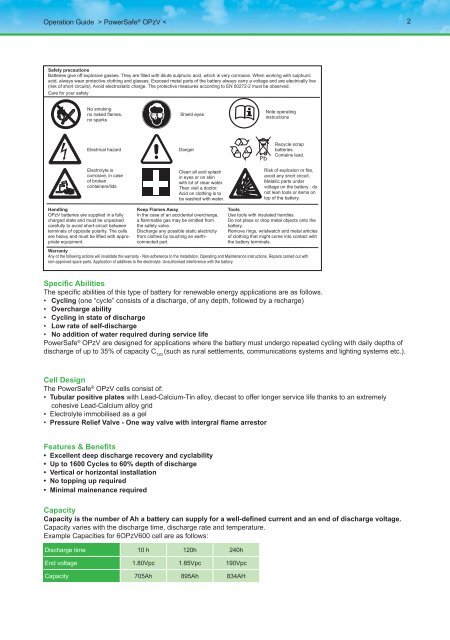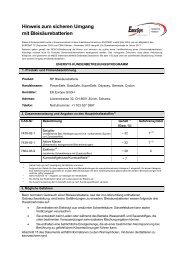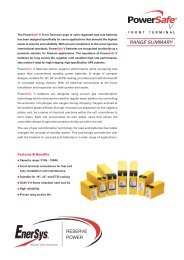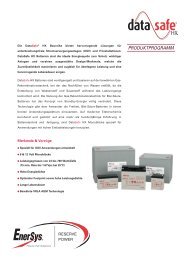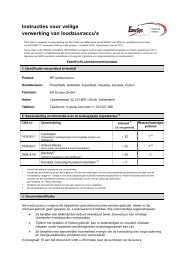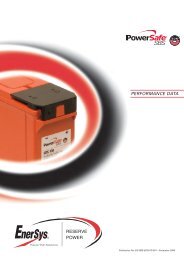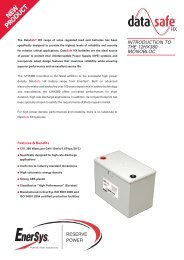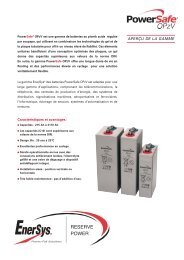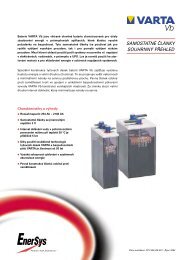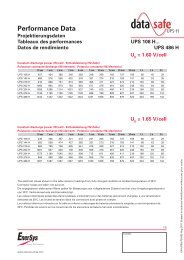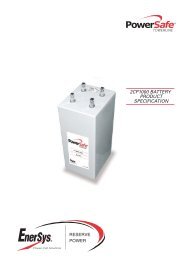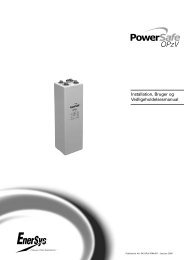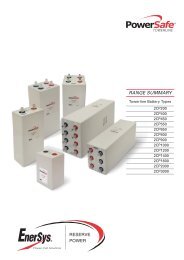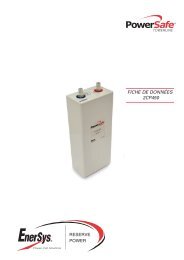Powersafe® Opzv - Enersys - EMEA
Powersafe® Opzv - Enersys - EMEA
Powersafe® Opzv - Enersys - EMEA
You also want an ePaper? Increase the reach of your titles
YUMPU automatically turns print PDFs into web optimized ePapers that Google loves.
Operation Guide > PowerSafe ® OPzV <<br />
Safety precautions<br />
Batteries give off explosive gasses. They are fi lled with dilute sulphuric acid, which is very corrosive. When working with sulphuric<br />
acid, always wear protective clothing and glasses. Exposed metal parts of the battery always carry a voltage and are electrically live<br />
(risk of short circuits). Avoid electrostatic charge. The protective measures according to EN 50272-2 must be observed.<br />
Care for your safety<br />
No smoking<br />
no naked fl ames,<br />
no sparks<br />
Electrical hazard<br />
Electrolyte is<br />
corrosive, in case<br />
of broken<br />
containers/lids<br />
Handling<br />
OPzV batteries are supplied in a fully<br />
charged state and must be unpacked<br />
carefully to avoid short-circuit between<br />
terminals of opposite polarity. The cells<br />
are heavy and must be lifted with appropriate<br />
equipment.<br />
Shield eyes<br />
Danger<br />
Clean all acid splash<br />
in eyes or on skin<br />
with lot of clear water.<br />
Then visit a doctor.<br />
Acid on clothing is to<br />
be washed with water.<br />
Keep Flames Away<br />
In the case of an accidental overcharge,<br />
a fl ammable gas may be emitted from<br />
the safety valve.<br />
Discharge any possible static electricity<br />
from clothes by touching an earthconnected<br />
part.<br />
Specifi c Abilities<br />
The specifi c abilities of this type of battery for renewable energy applications are as follows.<br />
• Cycling (one “cycle” consists of a discharge, of any depth, followed by a recharge)<br />
• Overcharge ability<br />
• Cycling in state of discharge<br />
• Low rate of self-discharge<br />
• No addition of water required during service life<br />
PowerSafe ® OPzV are designed for applications where the battery must undergo repeated cycling with daily depths of<br />
discharge of up to 35% of capacity C 120 (such as rural settlements, communications systems and lighting systems etc.).<br />
Cell Design<br />
The PowerSafe ® OPzV cells consist of:<br />
• Tubular positive plates with Lead-Calcium-Tin alloy, diecast to offer longer service life thanks to an extremely<br />
cohesive Lead-Calcium alloy grid<br />
• Electrolyte immobilised as a gel<br />
• Pressure Relief Valve - One way valve with intergral fl ame arrestor<br />
Features & Benefi ts<br />
• Excellent deep discharge recovery and cyclability<br />
• Up to 1600 Cycles to 60% depth of discharge<br />
• Vertical or horizontal installation<br />
• No topping up required<br />
• Minimal mainenance required<br />
Capacity<br />
Capacity is the number of Ah a battery can supply for a well-defi ned current and an end of discharge voltage.<br />
Capacity varies with the discharge time, discharge rate and temperature.<br />
Example Capacities for 6OPzV600 cell are as follows:<br />
Discharge time 10 h 120h 240h<br />
End voltage 1.80Vpc 1.85Vpc 190Vpc<br />
Capacity 705Ah 895Ah 834AH<br />
.<br />
Note operating<br />
instructions<br />
Recycle scrap<br />
batteries.<br />
Contains lead.<br />
Risk of explosion or fi re,<br />
avoid any short circuit.<br />
Metallic parts under<br />
voltage on the battery : do<br />
not lean tools or items on<br />
top of the battery.<br />
Tools<br />
Use tools with insulated handles.<br />
Do not place or drop metal objects onto the<br />
battery.<br />
Remove rings, wristwatch and metal articles<br />
of clothing that might come into contact with<br />
the battery terminals.<br />
Warranty<br />
Any of the following actions will invalidate the warranty - Non-adherence to the Installation, Operating and Maintenance instructions. Repairs carried out with<br />
non-approved spare parts. Application of additives to the electrolyte. Unauthorised interference with the battery.<br />
2


